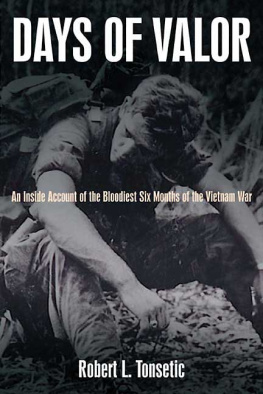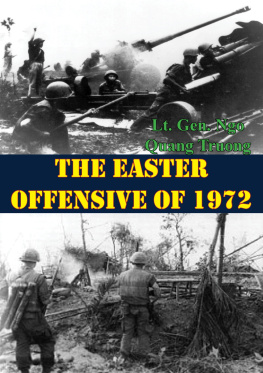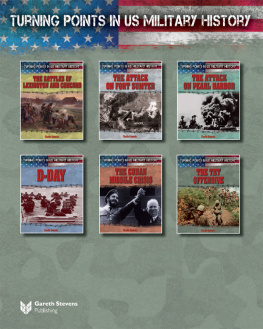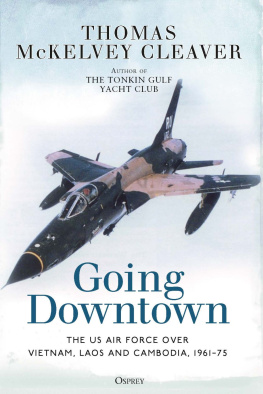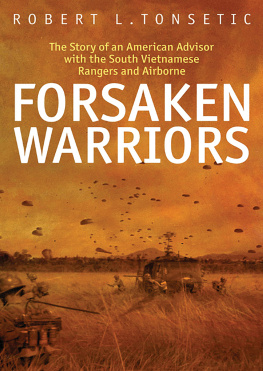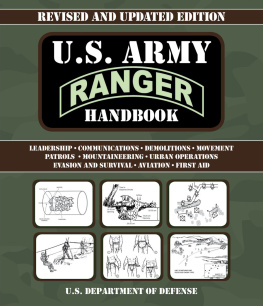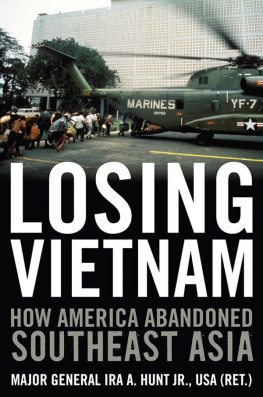

Published in the United States of America and Great Britain in 2009 by CASEMATE
908 Darby Road, Havertown, PA 19083
and
17 Cheap Street, Newbury, Berkshire, RG20 5DD
Copyright 2009 Robert L. Tonsetic
ISBN 978-1-935149-03-3
Cataloging-in-publication data is available from the Library of Congress and the British Library.
All rights reserved. No part of this book may be reproduced or transmitted in any form or by any means, electronic or mechanical including photocopying, recording or by any information storage and retrieval system, without permission from the Publisher in writing.
10 9 8 7 6 5 4 3 2 1
Printed and bound in the United States of America.
For a complete list of Casemate titles please contact:
CASEMATE PUBLISHERS (US)
Telephone (610) 853-9131, Fax (610) 853-9146
E-mail: casemate@casematepublishing.com
CASEMATE PUBLISHERS (UK)
Telephone (01635) 231091, Fax (01635) 41619
E-mail: casemate-uk@casematepublishing.co.uk
For the brave U.S. and South Vietnamese soldiers who wore the Maroon and Red Berets of the ARVN Rangers and Airborne.
INTRODUCTION
This book is about the authors experiences as a Senior Advisor to South Vietnamese Ranger and Airborne battalions during the latter years of the Vietnam War. During the years 19701971, the withdrawal of U.S. forces proceeded at a rapid pace, and the Republic of Vietnam Armed Forces (RVNAF) were assuming the major role in combat operations throughout the country. The story is written as a personal memoir of that period, but it is in no way representative of the total advisory effort in Vietnam. Thousands of U.S. officers, warrant officers, and non-commissioned officers from all branches of the armed services served in advisory capacities during the Vietnam War, along with numerous civilians representing various government agencies.
Surprisingly, few have written about their experiences, leaving a gap in the literature that needs to be filled lest the lessons learned be forgotten. While it is doubtful that future counter-insurgency operations will involve the numbers of U.S. combat forces that were deployed in Vietnam, it is likely that such conflicts will require the deployment of U.S. advisors to train and assist indigenous forces. Hopefully, future advisory efforts will benefit from the experiences of the MACV advisors.
The advisory effort in South Vietnam began in the mid-1950s, organized under the Military Assistance and Advisory Group (MAAG). In the early years, the emphasis was on training and equipping South Vietnamese forces, and U.S. advisors were forbidden from participating in a direct combat role, although they could accompany ground forces as observers and offer advice. The newly organized ARVN Ranger units were among the first to benefit from this U.S. advisory support. By 1961, the Communist insurgency had gained sufficient strength to seriously threaten the Diem regime, and the Kennedy administration increased the number of advisors to 3,200. A year later, U.S. military assistance to South Vietnam was reorganized with the establishment of the U.S. Military Assistance Command Vietnam (USMACV). Initially, priority was given to assigning advisors at the province and regimental levels. Beginning in 1964, the program was expanded and field advisors were assigned to selected districts and combat battalions.
The ramp-up in advisors continued in the ensuing years until all districts and combat battalions had U.S. advisors. The program was further expanded in 1968, when advisory teams were deployed to assist territorial Regional Forces (RF) and Popular Forces (PF). By 1970, the number of MACV field advisors peaked at around 14,000, of which some 3,000 were serving with combat units at the regimental and battalion levels.
The phase-down of the advisory program began in 1971. By 1 July of that year, all Battalion Combat Advisory Teams (BCATs), with the exception of Airborne and Marine teams, were phased out. Over the next two years, the drawdown continued and the U.S. MACV headquarters was disestablished in March of 1973, formally ending the advisory effort in South Vietnam. This book provides just one snapshot, among many thousands, of the overall advisory effort during the Vietnam War.
Regardless of when and where U.S. field advisors served in Vietnam, they faced daunting challenges. Immersed in an alien culture with little or no familiarity with the language, they provided much needed assistance to their South Vietnamese counterparts, often in extremely dangerous and hostile circumstances. With little external support, most served with distinction, receiving little recognition for their efforts.
The origins of this book can be traced to a manuscript that I wrote in 1971, at the conclusion of my advisory tour. The manuscript was never completed and was put aside until 2008, when I decided to expand upon it by doing further research on events that were such an important part of my overall Vietnam experience, bringing a sense of closure to that period of my life.
Research for the book was a daunting challenge, since surviving records are few in comparison to records pertaining to U.S. units and their operations during the Vietnam War. Mr. Richard Boylan, Senior Archivist at the National Archives and Records Administration, was extremely helpful in locating those records that do exist at the archives. Organization and cataloguing of the records is still a work in progress. Other sources used in my research were found at the U.S. Army Center for Military History, the Vietnam Center and Archive, Texas Tech University, and the Moise Vietnam War Bibliography. Other sources can be found in notes and bibliography sections of this book.
PROLOGUE
The Caribous twin Pratt Whitney engines roared to full power and the assault airlift aircraft sped down the Ton Son Nhut runway. Gaining altitude over the sweltering city, the aircraft banked south toward the Mekong Delta. The early morning sunlight glistened off the lush, green rice paddies below. Minutes after takeoff, the Caribou flew over the village of Binh Tri Dong.
In the rice paddies just north of the village, I spotted what remained of the dirt berm of an abandoned military outpost. I recognized it at once as the site of Fire Support Base Stephanie, occupied by the 199th Infantry Brigades 4th Battalion, 12th Infantry during the May Offensive of 1968. Two years earlier, the rifle company that I commanded defended the firebase and fought off determined North Vietnamese army assaults in the surrounding rice paddies.
My mind wandered back to May 1968. The now placid, emerald-green rice paddies bore no trace of the many brave men who died here two years earlier. Ill never forget that hallowed ground. Too many young Americans died there, some under my command. I wondered if the families of the young NVA who died there ever learned of their fate. There were the two young teenage NVA soldiers that I captured after they ambushed one of my squads. Were they still languishing in an ARVN POW camp? Some of the despair I had felt two years earlier surged back into my head. Put all that aside for now and focus on the present, I thought. Youre going to war again.
Our destination was Can Tho, some 100 miles south of Saigon. My orders read, Captain Tonsetic: assigned to Military Region 4, Advisory Team 96 for duty as Senior Advisor, Cai Cai Ranger Camp. My second combat tour in Vietnam was underway.



